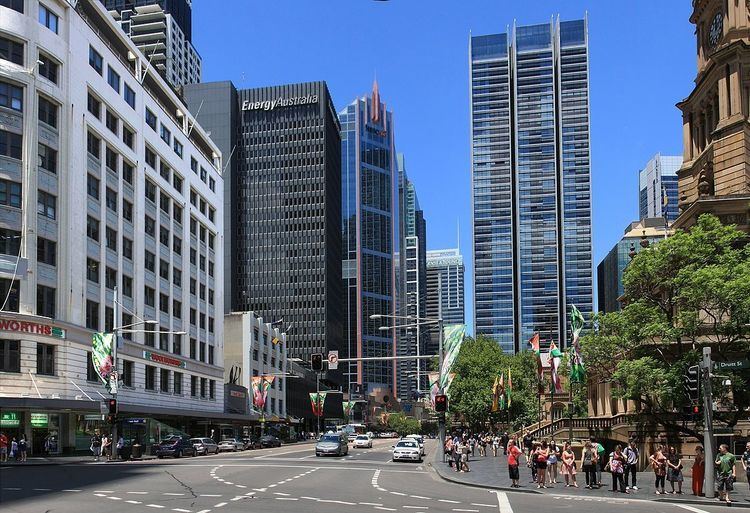Architect Eric Heath | ||
 | ||
George Street is a street in the central business district of Sydney in New South Wales, Australia.
Contents
Map of George St, New South Wales, Australia
It was Sydney's original high street, and remains one of the busiest streets in the city centre. It is about 3 km long, and connects a number of the city's most important buildings and precincts. There are more high rise buildings here than on any other street in Australia. Amongst Australia's 100 largest listed companies, more are located here than on any other street.
The street begins in the north end of Sydney in The Rocks, near the Sydney Harbour Bridge, and extends to the southern end of the city, near Central station and Ultimo, where it leads into Railway Square. From here Broadway is the continuation of George Street turning westwards, leading to the western suburbs as Parramatta Road.
History
The origins of George Street lie in the layout of the Sydney Cove colony. Captain Arthur Phillip placed the convicts and marines on the rocky western slopes of the bay. A track leading from the convicts' encampment in the area of The Rocks, past the marine barracks and alongside the banks of a stream to a brick pit, located near to the present location of Central Station. This track that eventually became George Street is one of the two original thoroughfares, along with the track that became Bridge Street. It is possible that George Street was the first street in Australia.
Until 1810 George Street was generally referred to as High Street in the English custom, although the northern part of the thoroughfare was also sometimes referred to as "Sergeant Major's Row" and, earlier, as "Spring Row" (since water carriers had originally established the route as a link between the Tank Stream, the Military encampment and the hospital). The Street was formally named for King George III of the United Kingdom by Governor Lachlan Macquarie in 1810.
On 8 August 1907 at Bateman's Crystal Hotel on George Street, a meeting resolved to form the New South Wales Rugby Football League, Australia's first professional rugby football association and predecessor to the modern-day National Rugby League. In 1937, Frank Jenner committed to telling ten different people on George Street about Christianity every day thenceforward.
Until 2016, George Street was the route for Sydney's Anzac Day parade until made unavailable by to CBD and South East Light Rail construction work. It now proceeds via Elizabeth Street.
Precincts
Being a major street through central Sydney, George Street is often seen in terms of a number of distinct sections or precincts. From south to north, they include:
Transport
On 8 December 1899, an electric tramway was opened along George Street to Harris Street. This reduced the traditional dependence on horses and human feet. In 1959 the trams were replaced by diesel buses. Until October 2015, George Street was the busiest street in Sydney in terms of number of buses per hour; most bus services to the inner western and north-western suburbs travelled along part of or most of George Street.
Many of the principal railway stations in the Sydney city centre are located on or near George Street. At the southern end of George Street, Railway Square is named after the adjacent Sydney Central station. Further north, Town Hall underground station is located under George Street near the Sydney Town Hall. This station was opened in 1932, as part of the construction of the City Circle, when the George Street roadway was opened outside the Sydney Town Hall. Further north still, Wynyard underground station was constructed in the same period at a location adjacent to George Street, with a major entrance to George Street near Hunter Street. Nearer to the northern end of the street, the Circular Quay station is located adjacent to George Street.
Future
In response to increasing bus congestion in the CBD, on 13 December 2012, the NSW Government announced a commitment to build a $1.6 billion light rail from Circular Quay down George Street to Central station, then across to Moore Park and down Anzac Parade. South of Moore Park the line will spit into two branches - one continuing down Anzac Parade to the nine ways at Kensington, and the second heading to Randwick via Alison Road.
In conjunction with the light rail works, the City of Sydney is to pedestrianise sections of George Street between Bathurst and Hunter Streets, with the intention of making George Street "Sydney's premier retail and pedestrian street". The state government announced it would support the plan. Light rail construction commenced in October 2015 resulting in disruption to the city.
